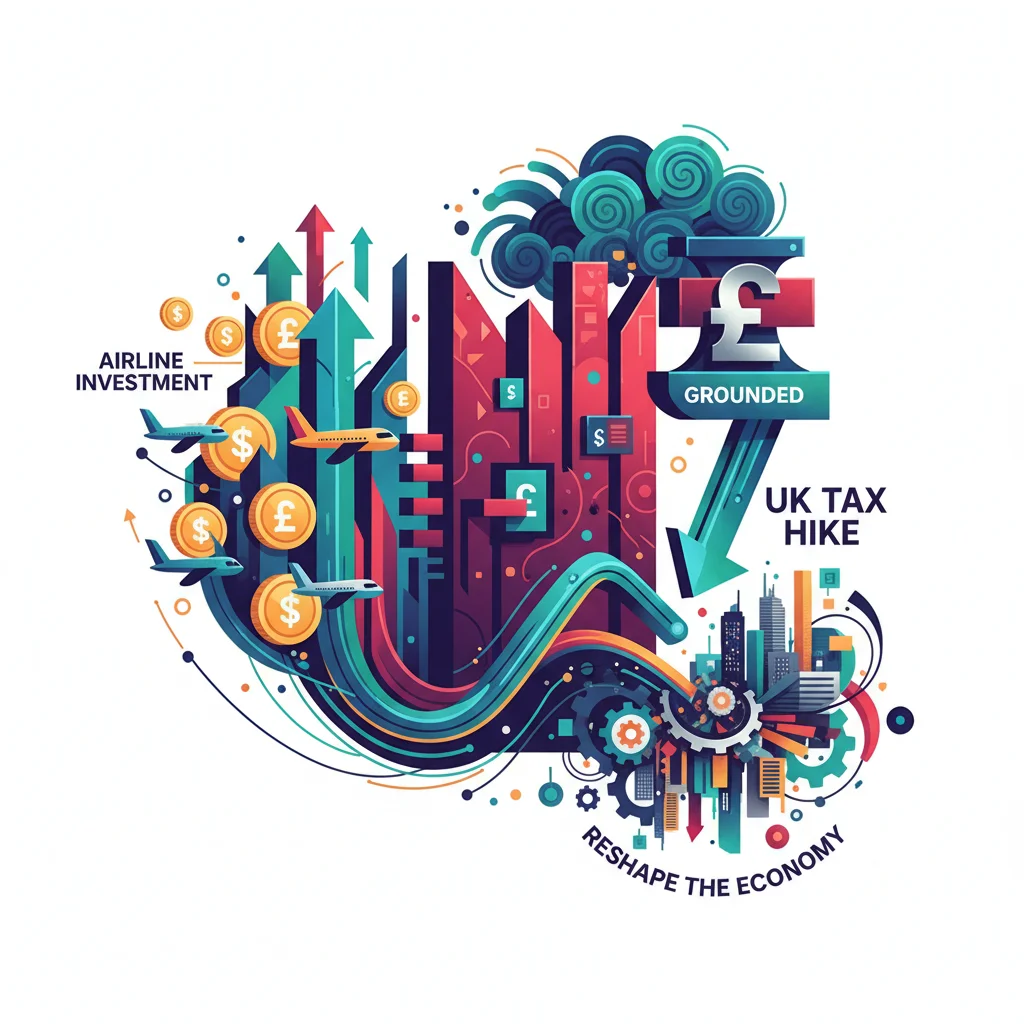
The Billion-Dollar Standoff: Why a UK Tax Hike Could Ground Airline Investment and Reshape the Economy
In the high-stakes world of aviation finance, capital is as mobile as the aircraft it buys. It flows to markets offering growth, stability, and favourable returns. Now, a storm is gathering over the United Kingdom’s aviation sector, pitting two of Europe’s largest low-cost carriers, Ryanair and Wizz Air, against the UK government in a tense battle over fiscal policy. The airlines have issued a stark ultimatum: if Air Passenger Duty (APD) continues to rise, their planned multi-billion-pound investment in new aircraft for the UK will be diverted elsewhere. This isn’t just a corporate dispute; it’s a critical stress test for the UK’s post-Brexit economic strategy, with profound implications for investors, consumers, and the nation’s connectivity to the global economy.
The warning, delivered by the outspoken heads of Ryanair and Wizz Air, Michael O’Leary and József Váradi respectively, suggests that the UK risks becoming a “fly-over” country rather than a destination for investment. They argue that punitive taxation makes the UK a less attractive market compared to European rivals, threatening to ground the very growth the government claims to be fostering. This standoff raises crucial questions about the delicate balance between government revenue, environmental commitments, and the creation of a competitive business environment. For anyone involved in investing, finance, or business leadership, this is a case study in regulatory risk and capital allocation playing out in real-time.
Decoding the Dispute: What is Air Passenger Duty?
At the heart of this conflict is the Air Passenger Duty (APD), a tax levied on all passengers departing from a UK airport. It is not a tax on airlines, but they are responsible for collecting it and passing it on to the government, meaning it is almost always baked into the final ticket price. The tax is structured in bands based on the final destination’s distance from London and the class of travel, a system designed to tax long-haul and premium travel more heavily.
The government views APD as a significant revenue generator and a tool to help meet its environmental targets by managing demand for air travel. However, airlines, particularly low-cost carriers whose business model is built on razor-thin margins and high passenger volume, see it as a direct impediment to growth and affordability. A potential increase, which airline bosses are bracing for, would directly challenge their ability to offer the low fares that stimulate demand and fill their planes.
To understand the financial stakes, let’s look at the current APD rates for economy passengers as of April 2024. Any increase would be added on top of these figures, directly impacting the cost of travel for millions.
| Band | Destination Distance (from London) | APD Rate (Reduced Rate – Economy) |
|---|---|---|
| Domestic | Flights within the UK | £7.00 |
| Band A | 0 – 2,000 miles | £13.00 |
| Band B | 2,001 – 5,500 miles | £88.00 |
| Band C | Over 5,500 miles | £92.00 |
Data sourced from the official UK government website. Note: Higher rates apply for premium cabin classes.
Kodak's Second Shot: Can a "Blue-Collar CEO" Reboot a Fallen Giant?
The Airlines’ Ultimatum: A Credible Threat or a Calculated Bluff?
The core of the airlines’ argument is rooted in the fundamental principles of modern economics and capital allocation. Michael O’Leary of Ryanair, known for his direct approach, stated that future aircraft deliveries would be redirected to other European countries that are actively lowering airport charges and taxes to stimulate post-pandemic recovery. According to the Financial Times, both Ryanair and Wizz Air have hundreds of new, more fuel-efficient aircraft on order, and the decision on where to base these assets is a fluid one, driven purely by projected return on investment.
This is not an idle threat. The ultra-low-cost carrier (ULCC) model thrives on flexibility. Unlike legacy carriers with entrenched hub-and-spoke systems, ULCCs can pivot their networks relatively quickly. They can shrink capacity in a high-cost market and redeploy multi-million-dollar aircraft to a more profitable one in a matter of months. For an investor analysing the stock market performance of these companies, this operational agility is a key strength, but for a government, it’s a formidable negotiating lever.
The airlines contend that by raising taxes, the UK is effectively choosing to forgo:
- Economic Growth: Fewer planes mean fewer routes, reduced tourism, and less business connectivity.
- Job Creation: Each new aircraft based in the UK supports a range of jobs, from pilots and cabin crew to ground staff and engineers.
- Environmental Progress: The new aircraft on order, like the Airbus A321neo and Boeing 737 Max, are up to 20% more fuel-efficient. Taxing the UK market discourages their deployment where they could replace older, less green planes (source).
The Ripple Effect: Beyond the Runway
The consequences of a potential investment freeze extend far beyond airport tarmacs. A reduction in low-cost airline capacity would have a cascading impact across the UK’s economic landscape. The tourism and hospitality sectors, which rely heavily on the influx of visitors brought in by affordable flights, would face significant headwinds. Reduced connectivity could also harm the UK’s appeal as a destination for foreign direct investment and as a hub for international business.
From a finance perspective, this uncertainty creates risk. Airport operators, service providers, and even retail companies with a presence in airports could see their valuations impacted on the stock market. It highlights the interconnectedness of fiscal policy and corporate investing decisions. A line item in a government budget can directly influence a CEO’s decision on where to deploy a billion dollars in assets, a decision that then ripples through countless other businesses. This is a clear example of how macroeconomic policy directly translates into microeconomic outcomes.
Geely's UK Gambit: Why a 100,000-Car Target is a Major Signal for the Global Economy
Aviation Taxes: A Global Comparison
To contextualize the airlines’ complaints, it’s useful to compare the UK’s APD to similar taxes across Europe. While many countries have aviation taxes, the UK’s is among the highest, particularly for long-haul flights. This disparity is central to the airlines’ claim that the UK is making itself uncompetitive.
Below is a simplified comparison of departure taxes for short-haul economy flights in several key European markets. While methodologies differ, it illustrates the competitive landscape.
| Country | Approximate Short-Haul Departure Tax (Economy) | Notes |
|---|---|---|
| United Kingdom | ~€15 (£13) | One of the highest in Europe. |
| Germany | ~€13 | “Luftverkehrsteuer” (Air Transport Tax). |
| France | ~€5 – €10 | “Taxe de solidarité sur les billets d’avion” (Solidarity Tax). Varies by destination. |
| Italy | ~€7 – €8 | Municipal surcharge varies by airport. |
| Spain | €0 | No specific departure tax, though airport fees apply. |
| Ireland | €0 | Abolished its €3 air travel tax in 2014 to boost tourism. |
Note: Figures are approximate and for illustrative purposes. Exchange rates and specific airport charges can affect the final cost. Source for comparison data: Transport & Environment analysis.
The case of Ireland is particularly telling. After abolishing its air travel tax, the country saw a significant surge in traffic and route development from airlines like Ryanair. This is the historical precedent that airline executives are implicitly pointing to in their warnings to the UK government.
The Intersection of Aviation, Finance, and Technology
Modern airlines are not just transport companies; they are sophisticated operations heavily reliant on data and financial technology. Route planning and aircraft deployment are determined by complex algorithms that model demand, operating costs, and potential profitability down to the single-seat level. A variable like APD is a critical input in these models. An increase can instantly render a marginal route unprofitable, triggering a strategic reallocation of assets.
Furthermore, the entire aviation ecosystem is underpinned by the global banking and finance sector. The hundreds of aircraft on order by Ryanair and Wizz Air are financed through complex leasing arrangements and multi-billion-dollar loans. The stability and predictability of the regulatory environment are key factors that financiers consider when underwriting this investment. Volatile and punitive tax policies increase the perceived risk, which can impact the cost of capital for airlines operating in that market. While discussions about using blockchain for ticketing or loyalty programs point to future innovations, the current reality is that the industry’s profitability is governed by more traditional, and brutal, financial metrics. Advanced fintech is used for everything from fuel-hedging and currency trading to managing revenue streams, and a sudden tax hike throws a wrench into these finely tuned systems.
The Mixologist's Portfolio: Investment Lessons from Buenos Aires' Economic Cauldron
Conclusion: Navigating the Path to a Competitive Future
The standoff between the UK government and its largest low-cost carriers is more than just corporate posturing. It is a critical juncture that will define the future of the UK’s aviation industry and its role in the global economy. The government is caught between the need to balance its books and meet climate goals, while the airlines are making rational, if ruthless, business decisions based on where they can achieve the best returns for their shareholders.
For investors and business leaders, the situation is a powerful reminder of the importance of monitoring the political and regulatory landscape. A change in tax policy can be as impactful as a shift in consumer demand or a spike in fuel prices. As the UK charts its course, it must decide whether the revenue gained from a higher APD is worth the potential loss of billions in investment, thousands of jobs, and the invaluable connectivity that underpins a modern, open economy. The world is watching, and the planes are ready to fly—the only question is where they will land.


